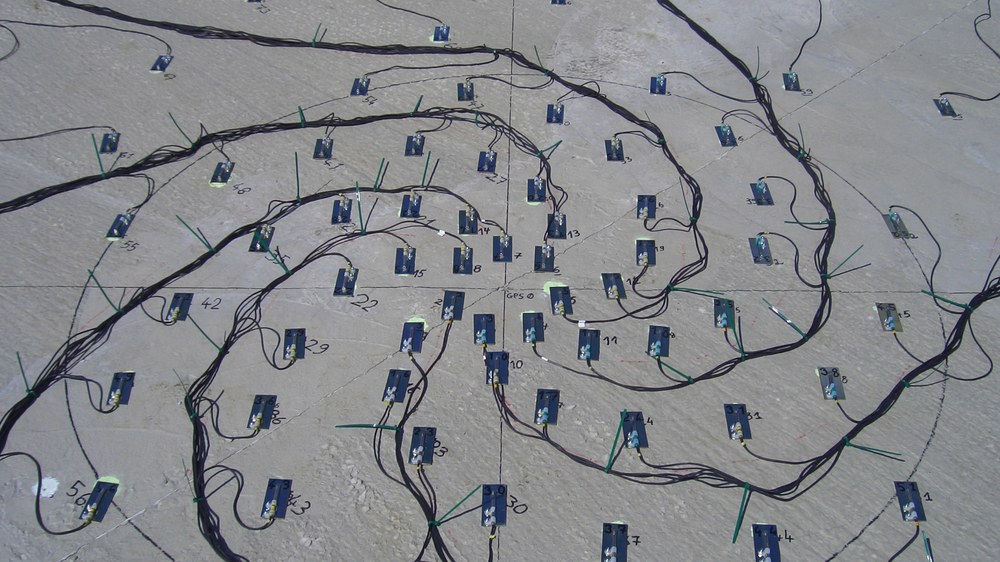Microphone array measurement and analysis methods

Microphone array technology can be used to locate and analyse sound sources on stationary and moving objects. This is an important prerequisite for making modern aircraft engines quieter. Acoustic measurements with single microphones can provide information about the spectral composition of an aircraft's noise signature and its evolution over time. However, for the development of noise reduction measures, there is a lack of information on where the individual noise sources are actually located. Only when the location of the noise sources is known can constructive or operational noise abatement measures be taken.
The Engine Acoustics Department has been using microphone arrays since 1978, initially for investigations on high-speed trains and later on aeroplanes. Today, sound source localisation using arrays of microphones is a standard procedure in research institutes and industry.
Enhanced beamforming
The principle of classic beamforming is relatively simple: the signals from many microphones are recorded simultaneously, then the individual signals are shifted in time to compensate for the propagation time of the sound between each individual microphone and the point on the object being analysed. When the time-corrected microphone signals are then added together, the components from sources at that point are added together constructively, while the signal components from sources at other locations are statistically averaged.
This method is known as delay and sum beamforming. This method is usually carried out with many points in a plane. A sound pressure spectrum is calculated for each point. In this way, maps of the sound sources of the target can be produced for all recorded frequency bands.
The sound sources on commercial aircraft can only be analysed by flying over them. In order to focus the array on the aircraft and compensate for the Doppler effect, the flight path and speed must be known. For such investigations, the Engine Acoustics Department has developed the ProSigMA program, which allows the localisation of sound sources on moving objects, with the results additionally adjusted for the disadvantageous imaging properties of a microphone array (deconvolution with the point broadening function) in order to obtain a higher dynamic range of the calculated sound source distributions.
SODIX: Source Directivity Modeling in Cross-Spectral Matrix
The entire sound field emitted by an aircraft engine is made up of the individual contributions of the inlet, the nozzles and the jet. The detailed investigation of these directional partial sound sources requires analysis methods that can be used to determine the absolute source strengths and directional characteristics. Conventional array methods such as classic beamforming do not provide absolute results due to overlapping effects and can only resolve the directional characteristics of the individual sources to a very limited extent due to spatial averaging across all microphone positions.
The SODIX inverse array method allows the absolute contributions of directional sound sources to be determined by modelling directional surrogate sound sources. For each sound source to be modelled, a source strength is determined in the direction of each microphone. Modelling is performed by minimising the difference between the measured cross-spectral matrix and the cross-spectral matrix simulated with the equivalent sound sources.
The evaluation of static measurements on turbofan engines on free-field test benches with SODIX has shown that the broadband sound sources can be modelled with high spatial resolution and the resulting far-field directivity can be reproduced very well. Another application for SODIX is sound source localisation in wind tunnels, where the signals from individual microphones are influenced by uncorrelated flow noise. Unlike classical beamforming methods, SODIX allows the mathematically correct elimination of the main diagonals of the cross-spectral matrix in the calculation, minimising the influence of uncorrelated noise.
Berlin Beamforming Conference
The Berlin Beamforming Conference takes place every two years in Berlin and is jointly organised by DLR - German Aerospace Center, TU Berlin and the Society for the Advancement of Applied Computer Science. The Berlin Beamforming Conference website contains a literature database on the topic of sound source localisation using microphone arrays.
